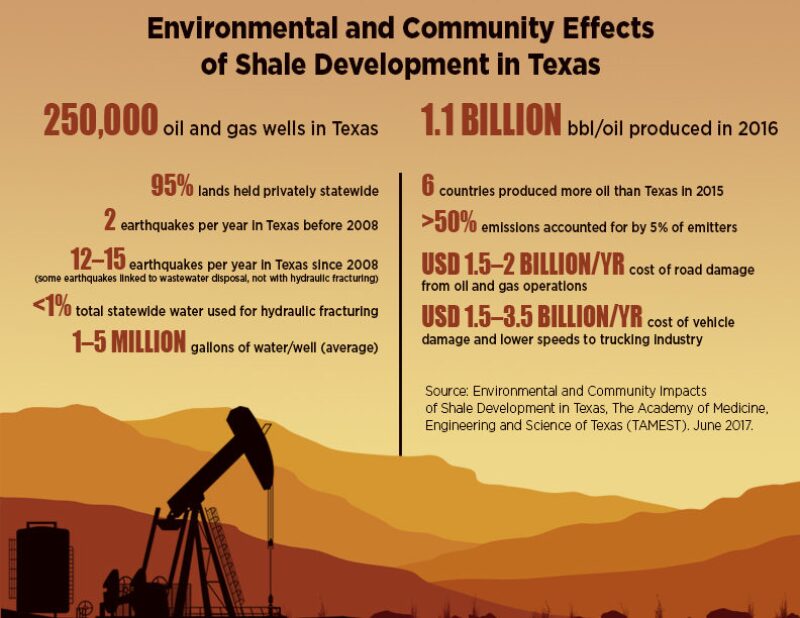The North American shale boom has had an enormous effect on the environment and communities in Texas and, indeed, throughout the US. Many studies have attempted to quantify this effect, and a task force from the The Academy of Medicine, Engineering, and Science of Texas (TAMEST) analyzed those studies and released a comprehensive analysis, “Environmental and Community Impacts of Shale Development in Texas.”
“It’s clear that shale energy development and the oil and gas industry has provided hundreds of thousands of jobs in those regions and provides state and local governments with tens of billions of dollars annually,” said Gene Theodori, professor in the Department of Sociology at Sam Houston State University and task force member. “It’s fair to say that not all of the effects of shale development have been positive.”

TAMEST is a consortium of Texas-based members of the National Academy of Sciences, Engineering, and Medicine and the state’s Nobel laureates. The task force within TAMEST examined six areas affected by shale development in Texas—geology and earthquake activity, land resources, air quality, water quality and quantity, transportation, and economic and social effects.
“The strength of the TAMEST study was bringing people with different perspectives together to try to come to an understanding of each of the task areas,” said Brian Stump, the Albritton Professor of Earth Sciences at Dedman College of Humanities and Sciences at Southern Methodist University. Stump, along with other members of the task force, spoke at a special session at the 2017 SPE Annual Technical Conference and Exhibition.
TAMEST members say they hope the report can serve as a touchstone for the public and policy makers to examine and understand the benefits, challenges, and effects of shale development in Texas and make informed decisions about future development. “It is hoped that this report will allow Texans and other states and nations to learn and benefit from the Texas experience,” said Christine Ehlig-Economides, chairperson of the TAMEST task force.
Gathering data from a wide range of technical studies, the TAMEST task force has attempted to present the information in a way that is accessible to the public.
“We find the same thing over and over from the general public,” Theodori said. “Folks always say, ‘we just want fact-based scientific information that we can understand.’ And, I think that the last part is the key.”

Earthquakes
The report points to the growing number of earthquakes in the state. According to the report, Texas recorded approximately two earthquakes per year before 2008. Since then, that number has risen to approximately 12–15. Some of these, the report says, are linked to wastewater disposal.
“We know there are earthquakes in Texas and that some of them have been linked to oil and gas operations. But, what remains unknown is a complete understanding of the physics of that process that can lead to these earthquakes and understanding the degree we can mitigate or eliminate them,” Stump said.
Addressing the increase in temblors, the state plans to raise the number of monitoring stations from 18 to 43. Water-disposal wells now must also receive approval from regulators.
Land Resources
Studying the effect shale development has on the land is hampered by the fact that 95% of the land in Texas is privately owned. Nonetheless, the report identifies two species that are threatened by shale development—the dunes sagebrush lizard and the lesser prairie chicken. While the report says that more studies are needed, it recommends limiting shale development’s effect on land by using horizontal wells to help drill multiple wells from a single pad.
Air
Most of the air pollution that results from shale development comes from a small number of so-called “superemitters.” According to the report, for most sources, more than 50% of emissions come from approximately 5% of emitters.
“It’s been known for decades in the air-quality community that a small subpopulation of vehicles on the road dominate emissions,” said task force member Dave Allen, the Melvin H. Gertz Regents Chair in Chemical Engineering at The University of Texas at Austin. Despite the known information on the source of air pollution, limited information exists concerning exposure to toxic emissions and their effect on health. The report, therefore, strongly recommends targeted research in that area.
Water
Regarding water quality, the report points out that the greatest danger to drinking water comes from surface leaks and spills, not from subsurface activities. And, while water usage has created many headlines, hydraulic fracturing, according to the report, accounts for less than 1% of the total water usage in Texas.
“Even though the overall amount of water used for hydraulic fracturing processes in Texas is low,” said task force member Danny Reible, a professor at Texas Tech University, “there are areas within the state where the amount used is much more important and will be of more concern.”
The report encourages continued research into ways to use poor-quality water in the process instead of fresh water.
Transportation
One of the largest effects of shale development in Texas is on roads and infrastructure. A boom brings a large influx of workers, which can strain communities. “What we found is that there are some negative impacts of shale development, particularly with the roads,” Theodori said. The report estimates that the cost of road damage from oil and gas operations is between $1.5 billion and $2 billion per year. Theodori added, “in some of these communities, the infrastructure has strained as migrant workers move in and some housing issues become apparent.”
Economy and Society
In addition to the strain on infrastructure, some communities have seen an imbalance in the benefits coming from development. “There have been a number of studies examining the uneven distribution of benefits and costs associated with shale development,” Theodori said. “What we found in reviewing the literature is that, in those counties where this work has been conducted, you find that nonlocal mineral owners are the primary beneficiaries of development in those shale plays. … The local residents bear the burden of the development. They live with it on a day-to-day basis, and much of that money is being moved out of the county.”
The report emphasizes that each community requires unique outreach efforts to address these issues, that there is no one-size-fits-all approach. Getting the correct, unbiased information into the hands of the public is vital, and the task force’s report is a big step in that direction. “More work needs to be done,” Theodori said, “but at least it’s a start.”


